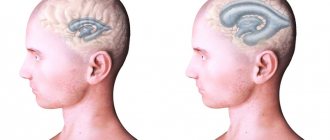Hydrocephalus is characterized by excessive accumulation of cerebrospinal fluid in the natural cavities of the brain. At the Yusupov Hospital, neurologists examine patients with hydrocephalus using modern equipment from leading manufacturers in the USA, Italy, and Germany. After determining the cause and severity of the disease, at a meeting of the expert council with the participation of professors, neurologists of the highest category, and neurosurgeons, a decision is made on the tactics of managing patients with hydrocephalus.
In recent years, to reduce intracranial pressure and restore normal circulation of cerebrospinal fluid, neurosurgeons have widely practiced progressive endoscopic techniques that do not require the installation of a shunt. They are performed by neurosurgeons at partner clinics of the Yusupov Hospital. If hydrocephalus of the brain develops in children, shunting may be the only operation if endoscopic intervention is not possible.
A little anatomy and physiology
Hydrocephalus (dropsy of the brain) (from the gr. “hydro” - water, “cephalon” - head) is a condition accompanied by an increase in the volume of the ventricles of the brain. The human brain has several interconnected cavities filled with cerebrospinal fluid (CSF). These cavities are called ventricles. The ventricular system consists of two lateral ventricles, which connect to the slit-like third ventricle (III ventricle), which, in turn, through a thin canal (Aqueduct of Sylvius) connects to the fourth ventricle (IV ventricle). Liquor is produced in the choroid plexuses of the ventricles and moves freely from the lateral to the fourth ventricle, and from there into the subarachnoid space of the brain and spinal cord (the subarachnoid space is the space between the brain and the dura mater), where it washes the outer surface of the brain. There it is reabsorbed into the bloodstream. Liquor is a clear, colorless liquid, very similar in appearance to water, containing a small amount of cells, protein and salts. In an infant, the amount of cerebrospinal fluid is about 50 ml, in a teenager and an adult - up to 120-150 ml. Liquor is constantly produced and absorbed; up to 500 ml of cerebrospinal fluid are produced per day by the choroid plexuses of the brain.
Any disturbance in the system of liquor production, liquor circulation and absorption of liquor leads to its excessive accumulation in the cavities of the brain, which is called hydrocephalus, or dropsy of the brain.
Excessive drainage
Excessive drainage of cerebrospinal fluid occurs when the valve is incorrectly selected according to the pressure parameter. If the valve opening pressure is too low, it can cause excessive drainage, causing the cerebral ventricle to compress and deforming the brain tissue. The patient experiences headaches that are most severe when standing.
In addition, nausea, vomiting, drowsiness and nervous system disorders, in particular double vision, appear. School-age children experience a decline in mental abilities.
Types of hydrocephalus
In cases where there is an obstacle on the path of the cerebrospinal fluid from the lateral ventricles to the exit from the fourth ventricle and the cerebrospinal fluid cannot freely enter the subarachnoid space, hydrocephalus is called non-communicating (closed, occlusive). In other cases, hydrocephalus is called communicating (open). Hydrocephalus can be primary (as the underlying disease) and secondary, i.e., a complication of other diseases (tumors, malformations of the central nervous system (CNS) and cerebral vessels, etc.). There are many classifications of hydrocephalus, but these are the main ones and are used most often.
Infection
Infection is the second type of complication. It poses a significant risk for any surgical procedure, most often when implanting a foreign body.
It manifests itself in the form of redness or suppuration along the edges of the suture or along the path of the drainage system under the skin. The surgeon fixes his attention on these signs. If left untreated, the wound may erode or open, and in more serious cases, the infection may cause chills and fever. Typically, the drain needs to be removed. Sometimes antibiotic therapy can be administered without removing the system.
Since the shunt is a foreign body, the patient may experience an allergic or inflammatory reaction. Inflammation at one of the drainage sites should be immediately shown to a neurosurgeon.
Manifestations of hydrocephalus
Impaired circulation and absorption of cerebrospinal fluid leads to its excessive accumulation and increased intracranial pressure. This manifests itself differently in children under 2 years of age and in older children.
The main symptom of the development of hydrocele in children under 2 years of age is accelerated growth of head circumference. The sutures of the skull in babies have not yet healed, and the size of the head increases because the bones of the skull are pushed apart from the inside by the growing brain. In the same way, a balloon increases in volume when we inflate it. There is a graph for head circumference growth. It must be measured every one to two months; this is done by the local pediatrician during preventive examinations. If the baby’s head grows faster than normal, this is an alarming symptom; it most often indicates the development of hydrocephalus, when accelerated head growth occurs due to an excess of cerebrospinal fluid in the ventricles of the brain. This is often the first symptom of the disease. In addition to accelerated head growth in children, an enlarged and bulging large fontanelle can be detected, which should close by approximately 1 year, but with hydrocephalus it can be open until 2 or even 3 years. The bones of the skull become thinner, the forehead becomes disproportionately enlarged and protruding. A venous network appears on the forehead and face. In more advanced cases, the eyes may droop downwards (Graefe's symptom). The tone of the leg muscles increases. Convulsive seizures may occur.
The child begins to lag behind in the rate of psychomotor development. He doesn't hold his head in time, doesn't sit, doesn't get up, doesn't play. A sick child is lethargic, apathetic, and at times unmotivatedly whiny. The baby may be experiencing a headache: he may clutch his head.
Most symptoms of increased intracranial pressure can only be recognized by an experienced pediatrician, neurologist or neurosurgeon, but parents can measure the rate of head growth themselves and check it using special charts. In any case, the accelerated growth of the child’s head circumference, as well as an incomprehensible lag in the pace of its development, should serve as a reason for a serious examination of the baby by a neurologist or neurosurgeon to rule out hydrocephalus.
In children over 2 years of age, the sutures of the skull heal, and the increase in intracranial pressure manifests itself differently. The classic picture is headaches with nausea and vomiting (usually at night or in the morning), changes in the fundus of the eye (the so-called papilledema, which can be detected by an ophthalmologist). Headaches, especially with nausea and vomiting, are symptoms that require evaluation by a neurologist or neurosurgeon. They can be caused by hydrocephalus, brain tumor, or malformations of the brain. Pediatricians often forget about this, and children are treated for a long time and aimlessly for gastritis, pancreatitis, biliary dyskinesia, poisoning and gastrointestinal infections, etc., and are brought to a neurologist and neurosurgeon late in a serious condition. It is necessary to insist on a consultation with a neurologist and examination in case of unclear headaches, regular episodes of nausea and vomiting, decreased vision, and in some cases this will allow an early diagnosis to be made and save the child’s life.
Other symptoms of hydrocephalus are varied and depend on the cause that caused it. These may be epileptic seizures, blurred vision, increased tone in the legs, pelvic disorders (incontinence or urinary retention), endocrine disorders (stunting or gigantism, premature sexual development, hypothyroidism - decreased production of thyroid hormones, obesity), decreased academic performance school, etc.
Diagnostics
In newborn children, the bones of the skull have not yet fused and hydrocephalus is determined visually. The head enlarges, the bones of the skull diverge, the fontanelle is tense and bulging; the skin is thin and shiny; The veins in the hairline area look full and swollen. Also symptoms are: vomiting, apathy, excitability, downward displacement of the eyes (“setting sun symptom”), etc. However, when the cranial sutures are not fused, the signs and symptoms of increased intracranial pressure seem subtle.
In older children and adults, the bones of the skull are fused and, when the ventricles expand, compression of the brain tissue occurs. Symptoms of increased intracranial pressure appear: headaches, nausea, vomiting, blurred vision, lack of coordination, psychopathological personality changes, lack of concentration and lethargy. These symptoms require additional instrumental diagnosis.
Causes of hydrocephalus in children
The causes of hydrocephalus are very diverse and largely depend on the age of the child.
- Hydrocephalus in the fetus. Modern types of prenatal diagnostics (for example, ultrasound examination) can detect hydrocephalus in an unborn baby. In most cases, it is caused by various malformations of the central nervous system (CNS). In 20%, dropsy is associated with intrauterine infections (cytomegaly, herpes, toxoplasmosis). When planning a pregnancy, parents should undergo testing for these infections, which often occur hidden, and treat them. This will avoid many problems with the baby's health. In rare cases, hydrocephalus is caused by genetic disorders.
- Hydrocephalus of newborns. Most often (up to 80%) dropsy in newborns is caused by malformations of the brain and spinal cord and the consequences of intrauterine infections. In approximately 20%, hydrocephalus is a consequence of birth trauma, especially in premature infants, which is accompanied by intracerebral or intraventricular hemorrhage and associated meningitis (inflammation of the meninges), which leads to impaired absorption of cerebrospinal fluid. It is extremely rare at this age that tumors and vascular malformations of the brain are detected, which can also cause the development of dropsy.
- Hydrocephalus in babies and older children (1-2 years and older). There are many reasons for the development of hydrocephalus in such children. These include tumors of the brain and spinal cord; consequences of meningitis, encephalitis (inflammation of the brain), various infectious diseases (for example, tuberculosis); malformations of the brain and cerebral vessels; consequences of hemorrhages; consequences of traumatic brain injury; genetic disorders. Sometimes the cause of hydrocephalus cannot be determined.
Participation in care
Children with implanted shunts should be monitored by a neurosurgeon throughout their lives. Most patients suffering from hydrocephalus, after implantation of a shunt system, can lead a normal life, but constant monitoring by loved ones in collaboration with a neurosurgeon is necessary.
The neurosurgeon monitors each patient to prevent drainage failure. The first time after implantation or re-operation - regularly, with a gradual transition to examinations once a year.
Relatives are advised to be able to recognize early signs of complications. Quick and accurate assessment of health problems is very important. Flu symptoms may mask symptoms of a blocked shunt. Quickly identifying them will allow you to plan a repeat operation and avoid an emergency.
Patients and their loved ones should pay close attention to signs and symptoms of complications. The main causes are: blockage, infection and excessive drainage.
How is the diagnosis made?
Diagnosis of hydrocephalus is based on the clinical picture, examination of the fundus, as well as additional research methods, such as neurosonography (NSG), ultrasound examination of the brain (in infants under 2 years), computed tomography (CT) or magnetic resonance imaging (MRI) of the brain brain The primary diagnosis can be made by a neonatologist, pediatrician, neurologist or neurosurgeon.
The most common operation is ventriculoperitoneal shunt (VPS).
Neurosonography is an effective method for diagnosing the state of the brain and ventricular system in children under 1.5-2 years of age, until the large fontanelle and other “ultrasound windows” - areas of the skull where the bones are very thin (for example, the temporal bone) and transmit ultrasound. It allows you to detect expansion of the ventricular system, intracranial space-occupying formations (tumors, hematomas, cysts), and some malformations of the brain. However, it should be remembered that NSG is not an entirely accurate method. The image of the brain is obtained with significantly lower resolution (less clear) than with CT and MRI.
If any brain pathology is detected, a CT or MRI is necessary. Without them, it is impossible to make an accurate diagnosis, identify the cause of hydrocephalus, and even more so carry out treatment. This equipment is expensive and is still not installed in all hospitals. In this case, parents should insist on having a CT or MRI scan performed at other centers or perform them themselves on a commercial basis. It should be borne in mind that a clinic that undertakes the treatment of children with hydrocephalus is required to have this equipment. Otherwise, we can recommend that parents choose another, more equipped hospital, at least in another city.
Emotional support
The physical side of hydrocephalus is only part of the problem of this disease. The patient and his relatives need to take into account his emotional factors.
Although surgery should resolve your hydrocephalus to some extent, you may feel fearful, depressed, irritable, or doubtful. If the patient is a child, it should be taken into account that he has the same feelings as an adult. If your child is feeling out of shape or uncomfortable because they need to visit the doctor frequently or have repeated tests, it is best to reassure them with simple explanations. If he knows what awaits him, he will be more willing to cooperate with you. Children, like adults, as a rule, do not like unpleasant surprises. A calm atmosphere among loving loved ones is the best environment for children. It is advisable to explain the phenomenon of hydrocephalus in words that the child can understand.
It is very important to know how the child feels and be able to explain to him what he is experiencing. The needles hurt. It is natural to cry and want to get rid of them. Being admitted to hospital is a new challenge for your child. You must tell him the truth in order to gain and secure his trust. Sincerity is the best way to maintain your child's trust.
Children over ten years of age are generally able to comprehend more complex concepts. They may associate signs and symptoms with their illness. Restrictions associated with the disease are easier for them to bear. Tell your doctor about your feelings and give him the right to guide you. Some people share their feelings with close friends, others need professional help. The health professionals treating you or your child are interested in your well-being and their goal is to do what is best for you and your loved ones.
Patients and the patient's parents should communicate with their doctor quite frequently. It is important to actively participate in this communication so that your doctor can better understand your needs and the needs of your loved ones.
Treatment of hydrocephalus
Endoscopic ventriculostomy avoids foreign body implantation.
If a diagnosis of hydrocephalus (of any cause) is made, the child should be examined by a neurosurgeon. Most often, children with hydrocephalus are treated surgically, and the neurosurgeon determines the indications and contraindications for surgery. Observing children with hydrocephalus only by a neurologist or pediatrician without the participation of a neurosurgeon is a mistake and sometimes leads to an unreasonable delay in surgical intervention.
It is not easy for parents to decide whether to undergo surgery. However, a prolonged increase in intracranial pressure causes a delay in psychomotor development, which cannot always be compensated after unreasonably delayed surgical intervention. It should also be noted that the excessively large head of a child suffering from dropsy, even after the operation, will no longer return to its previous size - it will only be possible to stop its further growth. Literally, it will be difficult for the child to carry it on his shoulders, in addition, it will cause many cosmetic problems in the future. Parents of children with hydrocephalus should be aware that even if the neurologist does not refer them to a neurosurgeon, they should take the initiative and organize this consultation themselves.
The purpose of the operation is to divert cerebrospinal fluid from the ventricles of the brain to other cavities of the body. The most common operation is ventriculoperitoneal shunt (VPS). Through a system of silicone catheters, cerebrospinal fluid from the lateral ventricle of the brain flows into the abdominal cavity, where it is absorbed between the intestinal loops. The amount of flowing liquor is regulated by a special valve. Catheters are placed under the skin and are not visible from the outside. More than 200 thousand such operations are performed annually in the world. Bypass systems have saved millions of children's lives.
Less commonly, the cerebrospinal fluid is diverted into the right atrium (ventriculoatrial shunt), into the cistern magna (Torkildsen operation), or the spinal canal at the lumbar level is connected by a catheter to the abdominal cavity (lumbo-peritoneal shunt).
With the development of modern endoscopic technology (an endoscope is inserted into the cavities of the human body through small incisions, allowing them to be examined and manipulated), it has become possible to treat patients without installing a shunt system. Using an endoscope, a bypass path for the outflow of cerebrospinal fluid is created deep in the brain. This is a very effective operation (called endoscopic ventriculostomy), which avoids the implantation of a foreign body, such as a shunt system, and thereby prevents many complications. Unfortunately, this operation can only help a limited number of patients (about 10% of the total number of patients) with some forms of occlusive hydrocephalus. In other cases, it is necessary to install a shunt system, since there will be no improvement from endoscopic surgery.
A successful operation stops the progression of the disease. Most children have the opportunity to return to normal life and attend kindergarten and school along with healthy peers.
In some cases, patients with hydrocephalus are not operated on, but are monitored and take Diacarb (a drug that reduces the production of cerebrospinal fluid) for a more or less long period of time. This is done in cases where there are no obvious signs of disease progression and increased intracranial pressure. Observation is carried out under the strict supervision of a neurologist or neurosurgeon with frequent examinations, measurements of the child’s head circumference, repeated NSG or CT studies.
Advertising
Surgery and hospitalization
Implantation of the shunt system is carried out by a neurosurgeon under sterile operating room conditions. In preparation for surgery, the hair is shaved to achieve maximum cleanliness. The operation is performed under general anesthesia, usually not for a very long time. The neurosurgeon drills a small hole in the skull bone, then makes a small incision in the dura mater that protects the brain and inserts a ventricular catheter into the lateral ventricle. To implant the rest of the bypass system, another incision is made and a tunnel is created subcutaneously to implant a peritoneal or cardiac catheter. The end of the catheter is carefully inserted either into the abdominal cavity or into the jugular vein leading to the ventricle of the heart. Catheters are connected to the valve using connectors on the valve itself. All parts of the shunt are thus connected into a single drainage system. At the end of the operation, small sterile dressings are applied to each incision.
Immediately after the operation, the patient is taken to the postoperative department. The patient is here from 1 hour to 1 day under close observation, then he is transferred to the ward. Most patients are discharged 7-10 days after clinical rehabilitation.
Myths about increased intracranial pressure
The diagnosis of “increased intracranial pressure”, “intracranial hypertension (ICH)” or “hypertensive-hydrocephalic syndrome”, as already mentioned, is often made and in some cases - without reason. How does increased intracranial pressure (ICP) manifest? As already noted, in children under 2 years of age such manifestations are, first of all, accelerated growth of head circumference, bulging and enlarged fontanelle, possible eye movement disorders, and delayed psychomotor development. Most often, all these disorders manifest themselves in a complex. In children over 2 years of age, these are headaches with nausea and vomiting, more often in the morning, changes in the fundus of the eye (detected during examination by an ophthalmologist). Of course, the clinical picture may be different, but without the above symptoms, the diagnosis of “increased intracranial pressure” is doubtful.
This is how pediatrician Evgeniy Komarovsky describes the diagnosis of “increased intracranial pressure.” “Since the main symptom of hydrocephalus is a rapid increase in head size, measuring head circumference is included in the standards of any preventive examination, starting, of course, from the moment of birth. It is very important to emphasize here that it is not the specific size expressed in centimeters that matters, but rather the dynamics of this indicator. That is, stating the fact that the boy Petya at 3 months has a head circumference of as much as 45 cm is not at all a reason to become depressed and urgently save this boy. But the fact that the head circumference has grown by 7 cm over the past month is already alarming and dangerous, and requires both serious attitude and active control. Let me emphasize once again - not immediate treatment, but control. And if the trend continues, then measures should be taken.”
Symptoms such as sleep and behavior disorders, hyperactivity, attention deficit, bad habits, poor academic performance, hypertonicity in the legs, “marble” skin pattern, including on the head, nosebleeds, chin trembling, tiptoe walking, are not in themselves indicate increased intracranial pressure. And yet, some neurologists make a diagnosis of ICH based on these complaints. Neurosonography, having become a huge boon for pediatrics and neurology, has made a significant contribution to the excessive and false diagnosis of “hypertensive-hydrocephalic syndrome.” NSG makes it possible to quickly obtain an image of the brain substance and measure the size of the ventricles. However, to clarify the diagnosis, as we have already said, CT and MRI are mandatory.
Blockage
The main type of complication is blockage of the system. Blockages can occur at any level of drainage. The holes in the ventricular catheter may become clogged with brain tissue or villous plexus tissue. It can also be blocked due to excessive contraction of the ventricular cavity due to too intense drainage of fluid from the ventricular cavity (constricted ventricle syndrome). Intestinal loops or necrotic tissue may adhere to the peritoneal catheter. Shunts inserted into a ventricle of the heart can become blocked by blood clots, pieces of brain matter, or tumor cells.
The shunt system may also be disconnected by disconnection of various elements of the shunt or by changes in the position of the catheter caused by the growth of the child. X-rays are necessary to check the integrity of the shunt.
Partial blockage of the system parts provokes the appearance of symptoms of increased intracranial pressure. Episodic headaches, nausea, apathy and decreased sensory functions may occur. Decreased performance at school or at work is the most common phenomenon in these conditions.
In case of complete blockage, symptoms develop more quickly (headaches, nausea, vomiting, blurred vision, loss of coordination and confusion). The patient falls into a stupor or coma. In such cases, urgent hospitalization is necessary for observation and appropriate treatment.
The surgeon performs a series of tests to locate and determine the extent of drainage blockage. Sometimes it is necessary to remove and replace part or all of the system.









